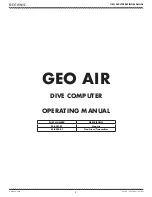
6
The meter saves the totalled consumed quantity every 10 minutes� After a power failure
this value is available as the current meter count� If a time-controlled reset is set, the
elapsed time of the set reset interval is also stored� So the possible data loss can be
maximum 10 minutes�
The meter can be reset as follows:
• Manual reset (→ 9.3.3).
• Time-controlled automatic reset (→ 9.3.3).
4.3.1 Consumed quantity monitoring with pulse output
Output 1 provides a counting pulse if the value set in [ImPS] is reached (→ 9.3.1).
4.3.2 Consumed quantity monitoring with preset meter
2 types of monitoring are possible:
• Time-dependent quantity monitoring
-Settings: [ImPS] = quantity x, [ImPR] = [no], [rTo] = time t�
-If the quantity x is reached during the time t, output 1 switches and remains
switched until the meter is reset�
-If the quantity x has not been reached after the time t, the meter is automati-
cally reset and counting starts again; output 1 does not switch�
• Quantity monitoring not time-dependent
-Settings: [ImPS] = quantity x, [ImPR] = [no], [rTo] = [OFF]�
-If the quantity x is reached, output 1 switches and remains switched until the
meter is reset�
4.4 Monitoring of temperatures
• The unit detects the current system temperature and shows it on the display
(→ chapter 10.2 Changing the display unit in the Run mode).
4.5 Volumetric flow monitoring / switching function
OUTx changes its switching state if it is above or below the set switching limits
(SPx, rPx)� The following switching functions can be selected:
• Hysteresis function / normally open (fig� 1): [OUx] = [Hno]�
• Hysteresis function / normally closed (fig� 1): [OUx] = [Hnc]�
First the set point (SPx) is set, then the reset point (rPx) at the requested
distance�
• Window function / normally open (fig� 2): [OUx] = [Fno]�
• Window function / normally closed (fig� 2): [OUx] = [Fnc]�
The width of the window can be set by means of the distance between SPx and
rPx� SPx = maximum value, rPx = minimum value�







































